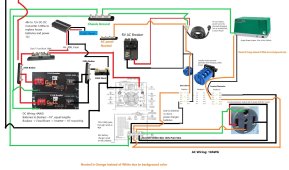CarlCruzin
New Member
I am in the process of wiring up my inverter and batteries. I have heard a lot about ground-neutral bonding and hazards associated with doing it incorrectly.
I am having difficulty finding when and why to bond the ground to the neutral. I couldn't find it addressed in my manual, and I assume that is because it is not of concern, but I want to double check since it is a safety concern.
(Sungoldpower 4kw 48v Pure sine Inverter/charger/ATS) https://cdn.shopifycdn.net/s/files/1/0323/4090/2025/files/LFP_Manual_sungoldpower.pdf?v=1639022296
I'm not sure if it's necessary, but I had extra transfer switch spots so I am switching to the generator neutral when on self-contained Generator/inverter power, and switching to the shore power neutral when on shore power.

I am having difficulty finding when and why to bond the ground to the neutral. I couldn't find it addressed in my manual, and I assume that is because it is not of concern, but I want to double check since it is a safety concern.
(Sungoldpower 4kw 48v Pure sine Inverter/charger/ATS) https://cdn.shopifycdn.net/s/files/1/0323/4090/2025/files/LFP_Manual_sungoldpower.pdf?v=1639022296
I'm not sure if it's necessary, but I had extra transfer switch spots so I am switching to the generator neutral when on self-contained Generator/inverter power, and switching to the shore power neutral when on shore power.




